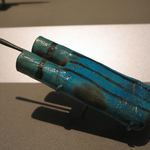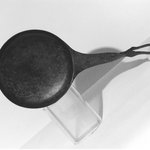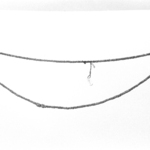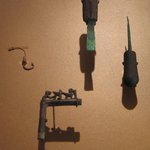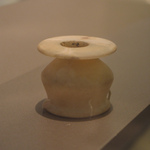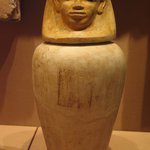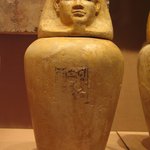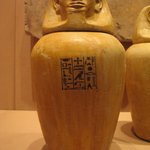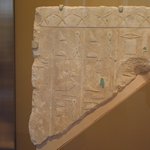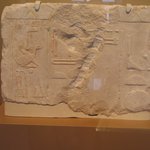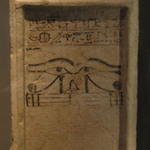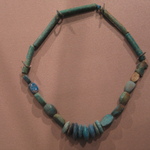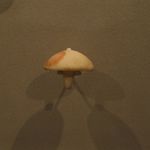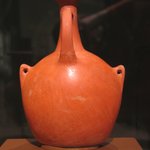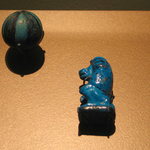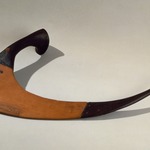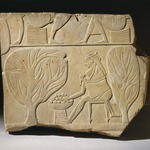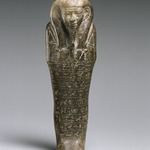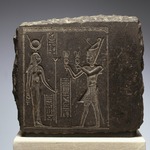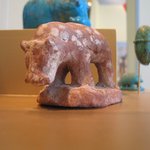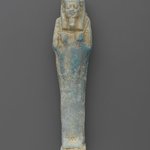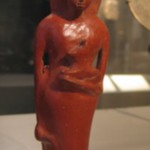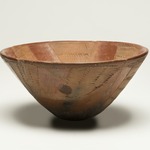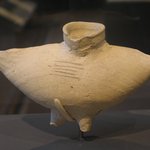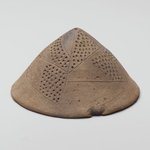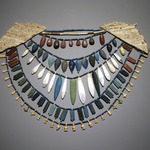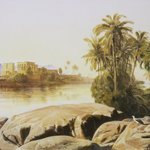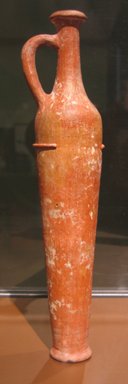
Egyptian Imitation of Western Asiatic Oil Bottle
Egyptian, Classical, Ancient Near Eastern Art
On View: Egyptian Orientation Gallery, 3rd Floor
Pottery Decoration
After a pottery vessel had dried to a leathery consistency, it was ready to be decorated and fired.
The simplest technique was to apply a layer of clay, paint, and water—called slip—on the pot’s drab exterior. Other methods included incising designs with pointed objects, polishing the surface with a cloth, or using a stone to burnish it, creating an attractive sheen.
Painted decorations appear on pottery throughout the Eighteenth Dynasty. Early designs included thin lines and long pendant triangles. Around the time of Thutmose III, artists invented a pastel blue paint that eventually dominated pottery decoration. A rare type of pot made exclusively for tombs was painted to reproduce the appearance of stones such as breccia.
After decorating the vessel, the potter placed it in a kiln for firing. Potters wrapped cords around large unfired vessels to prevent them from collapsing. These ropes burned away during firing, but traces of them remain on the sides of some pots.
After a pottery vessel had dried to a leathery consistency, it was ready to be decorated and fired.
The simplest technique was to apply a layer of clay, paint, and water—called slip—on the pot’s drab exterior. Other methods included incising designs with pointed objects, polishing the surface with a cloth, or using a stone to burnish it, creating an attractive sheen.
Painted decorations appear on pottery throughout the Eighteenth Dynasty. Early designs included thin lines and long pendant triangles. Around the time of Thutmose III, artists invented a pastel blue paint that eventually dominated pottery decoration. A rare type of pot made exclusively for tombs was painted to reproduce the appearance of stones such as breccia.
After decorating the vessel, the potter placed it in a kiln for firing. Potters wrapped cords around large unfired vessels to prevent them from collapsing. These ropes burned away during firing, but traces of them remain on the sides of some pots.
MEDIUM
Clay
DATES
ca. 1539-1390 B.C.E.
DYNASTY
Dynasty 18
PERIOD
New Kingdom
DIMENSIONS
12 5/8 x Diam. of foot 2 7/16 in. (32 x 6.2 cm) (show scale)



COLLECTIONS
Egyptian, Classical, Ancient Near Eastern Art
ACCESSION NUMBER
07.447.459
CREDIT LINE
Charles Edwin Wilbour Fund
PROVENANCE
Archaeological provenance not yet documented; 1907, collected, possibly at Esna (Ramessid), by Henri de Morgan of Francescas, France and New York, NY for the Brooklyn Museum.
Provenance FAQ
EXHIBITIONS
MUSEUM LOCATION
This item is on view in Egyptian Orientation Gallery, 3rd Floor
CAPTION
Egyptian Imitation of Western Asiatic Oil Bottle, ca. 1539-1390 B.C.E. Clay, 12 5/8 x Diam. of foot 2 7/16 in. (32 x 6.2 cm). Brooklyn Museum, Charles Edwin Wilbour Fund, 07.447.459. Creative Commons-BY (Photo: Brooklyn Museum, CUR.07.447.459_erg456.jpg)
IMAGE
overall, CUR.07.447.459_erg456.jpg. Brooklyn Museum photograph, 9/5/2007
"CUR" at the beginning of an image file name means that the image was created by a curatorial staff member. These study images may be digital point-and-shoot photographs, when we don\'t yet have high-quality studio photography, or they may be scans of older negatives, slides, or photographic prints, providing historical documentation of the object.
RIGHTS STATEMENT
Creative Commons-BY
You may download and use Brooklyn Museum images of this three-dimensional work in accordance with a Creative Commons license. Fair use, as understood under the United States Copyright Act, may also apply.
Please include caption information from this page and credit the Brooklyn Museum. If you need a high resolution file, please fill out our online application form (charges apply).
For further information about copyright, we recommend resources at the United States Library of Congress, Cornell University, Copyright and Cultural Institutions: Guidelines for U.S. Libraries, Archives, and Museums, and Copyright Watch.
For more information about the Museum's rights project, including how rights types are assigned, please see our blog posts on copyright.
If you have any information regarding this work and rights to it, please contact copyright@brooklynmuseum.org.
RECORD COMPLETENESS
Not every record you will find here is complete. More information is available for some works than for others, and some entries have been updated more recently. Records are frequently reviewed and revised, and we welcome any additional information you might have.





